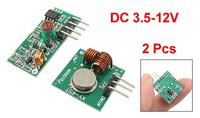boiler95
Member level 1
Hi Guys,
I'm trying to transfer data between PIC16F72 and raspberry pi (Model B, Rev2) using a cheap 433Mhz module from Ebay.

I'm planning to DIY a weather station and wireless is an essential part of it. The communication is one way from PIC to RPI and i have soldered a 17.3 cm wire as an antenna.
data needs to be transmitted probably for 12 meters max.
i'm using Manchester encoding here. PIC acts a s transmitter and RPI acts a receiver.
however the problem is i'm unable to transmit successfully anything.
i have the folowg transmitted from PIC16F72
4 Bytes preamble 0xAAAAAAAA
2 Bytes start of data 0xAB38
20 bytes of data (This is just AAAA.... , in future it will be replaces by data from all the sensors.)
1 byte of Check sum.
The problem i believe, is in the receiver part. the bloody data that i get is always corrupted no mater what !!!!!
i have tried sending 2000bps 2250bps .. (and much lower as well but in vain)
sometimes Preamble, start of data is detected but data is corrupted. but this happens at random sometimes nothing is detected. I'm been looking into it for days now without progress :bang:
i have posted the entire code for reference. Code for raspberry PI used the wringPI Api and is in C .. That of PIC is written in ASM for better control over timing.
i'm using pin 13 (wringPi pin 2) on RPI for reception.
the idea is to detect atleasst 3 bytes of preamble. and then the start of data and then the data itself.
i haven't checked the checksum part yet, as i'm printing the data received and checking it manually.
on the PIC side, i'm using RB5 as an o/p port connected to the TX.
Timer 1 is used to precisely to construct ( send) the required waveform with the correct timing i have tried sending 400us , 600us and 200us pulses with 400us being much better in the sense that the receiver is at least able to detect corrupt data.
i'm using RC4 as a led o/p. and Rb0 for external interrupt to start the transmission.
Any help is appreciated.
Thanks,
VirtualVat
This is the transmitter code. (PIC)
I'm trying to transfer data between PIC16F72 and raspberry pi (Model B, Rev2) using a cheap 433Mhz module from Ebay.

I'm planning to DIY a weather station and wireless is an essential part of it. The communication is one way from PIC to RPI and i have soldered a 17.3 cm wire as an antenna.
data needs to be transmitted probably for 12 meters max.
i'm using Manchester encoding here. PIC acts a s transmitter and RPI acts a receiver.
however the problem is i'm unable to transmit successfully anything.
i have the folowg transmitted from PIC16F72
4 Bytes preamble 0xAAAAAAAA
2 Bytes start of data 0xAB38
20 bytes of data (This is just AAAA.... , in future it will be replaces by data from all the sensors.)
1 byte of Check sum.
The problem i believe, is in the receiver part. the bloody data that i get is always corrupted no mater what !!!!!
i have tried sending 2000bps 2250bps .. (and much lower as well but in vain)
sometimes Preamble, start of data is detected but data is corrupted. but this happens at random sometimes nothing is detected. I'm been looking into it for days now without progress :bang:
i have posted the entire code for reference. Code for raspberry PI used the wringPI Api and is in C .. That of PIC is written in ASM for better control over timing.
i'm using pin 13 (wringPi pin 2) on RPI for reception.
the idea is to detect atleasst 3 bytes of preamble. and then the start of data and then the data itself.
i haven't checked the checksum part yet, as i'm printing the data received and checking it manually.
on the PIC side, i'm using RB5 as an o/p port connected to the TX.
Timer 1 is used to precisely to construct ( send) the required waveform with the correct timing i have tried sending 400us , 600us and 200us pulses with 400us being much better in the sense that the receiver is at least able to detect corrupt data.
i'm using RC4 as a led o/p. and Rb0 for external interrupt to start the transmission.
Any help is appreciated.
Thanks,
VirtualVat
Code C - [expand]
This is the transmitter code. (PIC)
Code ASM - [expand]